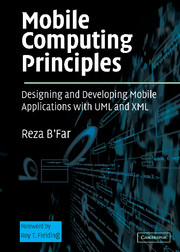Book contents
- Frontmatter
- Contents
- Foreword by Roy T. Fielding
- Acknowledgments
- SECTION 1 INTRODUCTIONS TO THE MAIN TOPICS
- SECTION 2 DEVICE-INDEPENDENT AND MULTICHANNEL USER INTERFACE DEVELOPMENT USING UML
- SECTION 3 ADDITIONAL DIMENSIONS OF MOBILE APPLICATION DEVELOPMENT
- Chapter 9 Mobile Agents and Peer-to-Peer Architectures for Mobile Applications
- Chapter 10 Wireless Connectivity and Mobile Applications
- Chapter 11 Synchronization and Replication of Mobile Data
- Chapter 12 Mobility and Location-Based Services
- Chapter 13 Active Transactions
- Chapter 14 Mobile Security
- SECTION 4 PUTTING THE PROJECT TOGETHER
- References
- Index
Chapter 11 - Synchronization and Replication of Mobile Data
from SECTION 3 - ADDITIONAL DIMENSIONS OF MOBILE APPLICATION DEVELOPMENT
Published online by Cambridge University Press: 03 September 2009
- Frontmatter
- Contents
- Foreword by Roy T. Fielding
- Acknowledgments
- SECTION 1 INTRODUCTIONS TO THE MAIN TOPICS
- SECTION 2 DEVICE-INDEPENDENT AND MULTICHANNEL USER INTERFACE DEVELOPMENT USING UML
- SECTION 3 ADDITIONAL DIMENSIONS OF MOBILE APPLICATION DEVELOPMENT
- Chapter 9 Mobile Agents and Peer-to-Peer Architectures for Mobile Applications
- Chapter 10 Wireless Connectivity and Mobile Applications
- Chapter 11 Synchronization and Replication of Mobile Data
- Chapter 12 Mobility and Location-Based Services
- Chapter 13 Active Transactions
- Chapter 14 Mobile Security
- SECTION 4 PUTTING THE PROJECT TOGETHER
- References
- Index
Summary
Doubt is the key to knowledge.
Persian proverbINTRODUCTION
The word replicate means “to produce a copy of itself” and originates from the Latin word replicates. The word synchronize is defined by the Webster dictionary to mean “to represent or arrange (events) to indicate coincidence or coexistence.” Synchronization and replication are two essential operations in distributed computing. Although synchronization can mean a variety of things, replication is typically used in reference to data. Like the literal definitions of synchronization and replication in the English language, their definitions within the field of computing are different but related. In this chapter, we will limit our discussion of synchronization and replication to data synchronization and data replication. As you may have already noted, we used the term synchronization, in Chapter 8, when synchronizing contents and actions transmitted across multiple communication channels. We are discussing synchronization in the context of data replication in this chapter.
Data replication, in its broadest sense, simply refers to copying data from one or more data storage locations to one or more other data storage locations. Note that these locations are virtual locations and not physical locations—it is not required for the virtual locations to be at different physical locations. The taxonomy of the types of replication technologies depends on the domain problem as well as the infrastructure on which replication is being performed. However, we can break nearly all data replication into two groups: complete replication and partial replication.
- Type
- Chapter
- Information
- Mobile Computing PrinciplesDesigning and Developing Mobile Applications with UML and XML, pp. 652 - 675Publisher: Cambridge University PressPrint publication year: 2004



